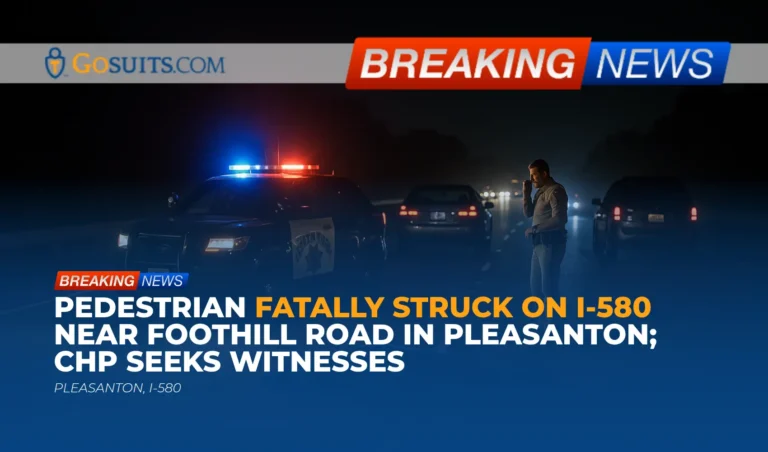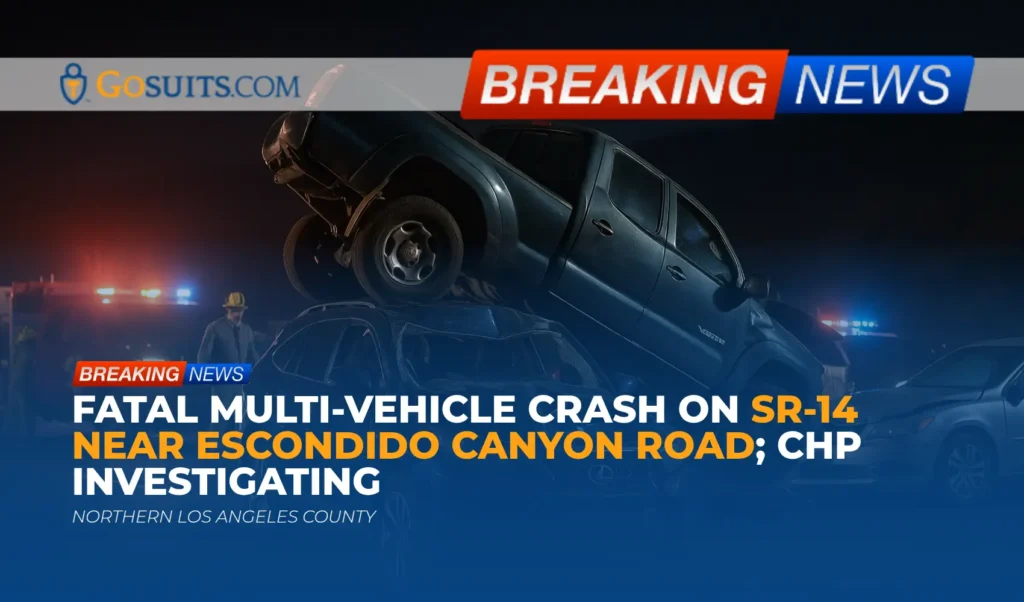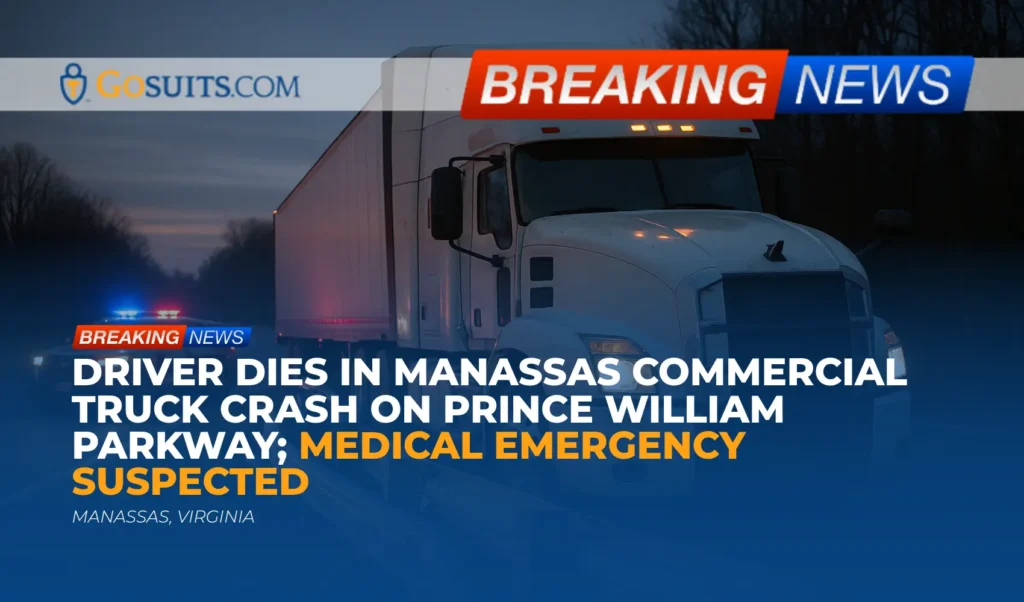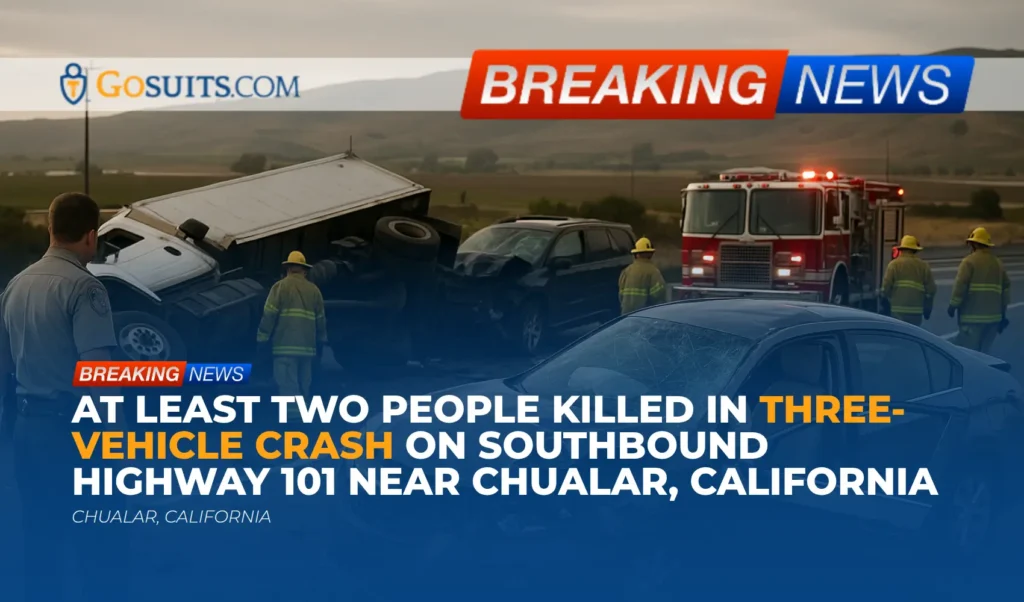- Overview of the Pleasanton I-580 Pedestrian Fatality
- What Authorities Have Reported So Far
- Why Pedestrian Freeway Collisions Happen at Night
- How a California Freeway Fatality Investigation Typically Proceeds
- Where Families Can Obtain Official Information and Records
- Family Rights After a Fatal Freeway Collision in California
- Potential Civil Liability Considerations in Multi-Vehicle Pedestrian Crashes
- Insurance Coverages That May Apply
- Practical Steps to Protect a Potential Claim
- Context and Safety Data
- Commentary from Gosuits Pleasanton, California Personal Injury Attorney
- Why Timely Action Matters
Overview of the Pleasanton I-580 Pedestrian Fatality
A tragic collision on eastbound I-580 just east of Foothill Road in Pleasanton occurred on Thursday night, October 9, at approximately 8:58 p.m. According to statements released by the California Highway Patrol (CHP), the incident involved a pedestrian in the freeway lanes and at least one passing vehicle. The pedestrian was pronounced deceased at the scene. CHP’s Dublin Area Office is leading the investigation and has asked the public for assistance.
Events like this are profoundly painful for families and for drivers who may be involved. In the immediate aftermath, information is usually limited, and it can take days or weeks for investigators to gather and analyze evidence. This article summarizes what has been publicly reported, explains how investigations of freeway fatalities typically proceed, outlines the types of records families can request, and offers general legal context relevant to civil personal injury and wrongful death matters in California. It is intended to be compassionate, factual, and educational.
What Authorities Have Reported So Far
Time and location
CHP reported that the incident took place around 8:58 p.m. on Thursday, October 9, on eastbound I-580 just east of Foothill Road in Pleasanton. This area is within Alameda County and falls under the CHP Golden Gate Division’s Dublin Area Office for patrol and investigation.
Preliminary account
Based on CHP’s preliminary statements, a pedestrian entered the eastbound lanes of I-580 and was struck by a passing vehicle. After the initial impact, the pedestrian reportedly came to rest in the freeway lanes and is believed to have been subsequently struck by multiple vehicles. The pedestrian was pronounced deceased at the scene. CHP has not released additional identifying information.
Witness request
Investigators are asking anyone with information or dash-camera footage to contact the CHP Dublin Area at 925-828-0466. Witness accounts and video can materially assist in reconstructing the sequence of events, identifying all involved vehicles, and clarifying visibility and traffic conditions.
Why Pedestrian Freeway Collisions Happen at Night
While every incident has unique facts, nighttime pedestrian collisions on high-speed roadways share familiar risk factors. Freeways are not designed for pedestrian traffic. Speeds are higher, sight distances can be limited by darkness, roadway curvature, grade, or vehicles ahead, and drivers do not anticipate encountering a person on foot in the travel lanes. If a pedestrian is on foot due to a disabled vehicle, disorientation, or other circumstances, the danger rises sharply.
Common contributing factors seen in similar cases include:
- Low visibility conditions at night, especially where there is limited roadway lighting, dark clothing, rain, glare, or visual obstructions created by traffic.
- High approach speeds that reduce reaction time and increase stopping distances for drivers.
- Multiple-vehicle dynamics, where after an initial impact a person may come to rest in a travel lane, increasing the risk of secondary impacts by drivers who cannot see and react in time.
- Driver attention and spacing, including following distance and the ability to see beyond a vehicle ahead that may obscure a roadway hazard.
- Emergency maneuvers that can trigger chain reactions or force drivers into difficult choices to avoid sudden hazards.
Discussing these factors is not to speculate about this particular tragedy. Rather, it recognizes the known safety realities of nighttime freeway conditions and why agencies take a methodical approach to documenting lighting, traffic flow, roadway geometry, and vehicle evidence.
How a California Freeway Fatality Investigation Typically Proceeds
CHP investigators usually follow a structured process when responding to a fatality on the interstate:
- Scene control and medical response: First responders secure the scene, assess injuries, and coordinate with emergency medical services and the county coroner’s office. Traffic control reduces secondary crashes.
- Physical evidence documentation: Officers measure and photograph skid marks, debris fields, vehicle damage, lighting and visibility conditions, roadway signage, and lane geometry. They note weather and surface conditions.
- Vehicle identification: They identify involved vehicles and attempt to locate any additional vehicles that may have made contact. This can involve public witness appeals and review of any available traffic or private cameras.
- Witness interviews: Statements from involved drivers, passengers, and independent witnesses are gathered, along with any dash-cam or onboard telematics data.
- Toxicology and medical examiner coordination: The county coroner or medical examiner will take custody of the decedent and, where appropriate, conduct examinations and toxicology pursuant to local protocols.
- Collision report preparation: Investigators prepare a Traffic Collision Report with diagrams and narrative. Supplemental reports may follow as more evidence is developed.
Families can usually request the Traffic Collision Report after it is finalized by CHP, though release times vary depending on the complexity of the investigation.
Where Families Can Obtain Official Information and Records
CHP Dublin Area Office (investigating agency)
The CHP Dublin Area is managing the investigation and has asked witnesses to call 925-828-0466. Location and office resources can be found through the CHP’s Area Office page for Dublin within the Golden Gate Division. See CHP Dublin Area Office.
To request a copy of the Traffic Collision Report, CHP uses the CHP 190 request form. Instructions and the form are available at the CHP website: How to Order a Report. There may be eligibility requirements for who can receive a full report, and fees can apply.
County medical examiner/coroner
In Alameda County, the coroner’s functions are handled through the county’s coroner or medical examiner system. Next of kin can typically obtain information about identification, release of remains, and potential autopsy reports through that office. Procedures vary by county. If uncertain who to call first, contacting the CHP investigating office for guidance on the appropriate coroner contact is a sensitive and practical starting point. Funeral homes can also coordinate with the coroner’s bureau on behalf of families.
Death certificates (State of California)
Certified copies of death certificates are generally available through the county recorder or the State of California once the death has been registered. The California Department of Public Health provides information on obtaining certified copies via its Vital Records unit: California Vital Records. Processing times and eligibility requirements apply.
Potential additional sources of information
- Tow operators and storage yards: If a vehicle was towed, the yard may have photos, condition notes, and chain-of-custody records. The investigating officer or CHP dispatch can identify the storage location.
- 911 call records: Recordings and logs are sometimes requested through public records processes. Release is discretionary and can be limited by law. The investigating office can advise on whether such requests are accepted and how to submit them.
- Caltrans District 4: For questions about roadway lighting, signage, or maintenance in the I-580 corridor, the public information page for Caltrans District 4 is here: Caltrans District 4. Claims involving alleged dangerous conditions of state highways follow specific rules and deadlines.
Family Rights After a Fatal Freeway Collision in California
California law provides civil remedies that may be available to families following a fatal collision. The applicability of any remedy depends on the facts, which must be carefully evaluated. The information below is general and publicly available through government sources.
Wrongful death
Eligible family members may bring a civil wrongful death action under California Code of Civil Procedure section 377.60. This statute identifies who may bring claims and the general nature of recoverable damages. See CCP § 377.60.
Survival actions
Separate from wrongful death, a representative of the decedent’s estate may bring certain claims that the decedent could have pursued if they had survived, as provided by California’s survival statutes. These claims are distinct in purpose and damages from wrongful death and are typically litigated together when appropriate. See California Code of Civil Procedure, Survival Actions.

Deadlines
- General statute of limitations: Most wrongful death actions in California are subject to a two-year limitation period. See CCP § 335.1.
- Claims against public entities: If a claim involves a public entity, such as the State of California or Caltrans, strict claim presentation rules under the Government Claims Act typically require a written claim within six months. See Gov. Code § 911.2. Additional rules apply if the claim proceeds to a lawsuit.
Because deadlines can be complex and fact-dependent, many families choose to consult a qualified attorney early to understand which time limits apply.
Potential Civil Liability Considerations in Multi-Vehicle Pedestrian Crashes
Freeway pedestrian fatalities can present difficult liability questions. The law recognizes duties for both drivers and pedestrians, while also acknowledging the realities of nighttime highway driving. In civil cases, liability often turns on careful analysis of visibility, speed, driver attentiveness, lighting, and the timing of each event in a chain of impacts.
Driver duties and stopping requirements
California drivers must operate at a safe speed for conditions and maintain a proper lookout. The state’s “basic speed law” requires drivers not to drive at a speed greater than is reasonable or prudent having due regard for weather, visibility, and traffic on the highway. See Veh. Code § 22350. When a collision causes injury or death, drivers have a duty to stop and fulfill specific obligations. See Veh. Code § 20001.
Pedestrian duties and freeway restrictions
Pedestrians outside a crosswalk must yield the right-of-way to vehicles, though drivers still must exercise due care for pedestrian safety. See Veh. Code § 21954. Freeways typically restrict pedestrian access, and walking in the lanes of a freeway is dangerous under any circumstance. In civil cases, comparative fault principles can consider the conduct of all involved, including any pedestrian conduct and each driver’s actions, based on the evidence.
Multiple impacts and identification of all involved vehicles
In a sequence where several vehicles may have made contact, it is important to identify all involved vehicles and drivers. Some drivers may not realize contact occurred or may be unaware they struck an object already in the roadway. Investigators evaluate vehicle damage patterns, undercarriage transfer, debris traces, and witness statements to determine the role of each vehicle and the timing of impacts. Civil liability, if any, can differ between the initial impact and secondary impacts depending on the facts.
Public entity considerations
There are rare scenarios where claims are considered regarding roadway conditions, lighting, or signage. Those claims involve technical standards and complex legal hurdles, and they require adherence to the Government Claims Act, including the six-month presentation deadline noted above. See Gov. Code § 911.2. The presence of a roadway factor does not mean a public entity is responsible, but it can be one of many elements investigators examine in serious collisions.
Insurance Coverages That May Apply
Insurance can become a critical part of addressing medical bills, funeral costs, and other losses. The types of coverage that may be relevant in a pedestrian freeway fatality include the following. The information below is general and not case-specific.
- At-fault driver liability coverage: If a driver is found civilly responsible, their auto liability coverage may respond to lawful claims asserted by eligible family members.
- Uninsured/Underinsured Motorist (UM/UIM): Pedestrians in California may be covered by their own auto policy’s UM/UIM coverage even though they were on foot, and sometimes by the UM coverage of a household member, depending on policy terms. This can be especially important if a driver fled the scene or coverage is inadequate. The California Department of Insurance provides consumer guidance on auto coverages: California Department of Insurance Auto Insurance Guides.
- Medical payments coverage (MedPay): Some auto policies include optional MedPay, which can help with certain expenses regardless of fault, subject to policy limits and terms.
- Life insurance or accidental death benefits: Separate from auto insurance, life or accidental death policies may provide benefits to designated beneficiaries.
Before contacting any insurance company to open a claim or give a statement, it is wise to speak with a qualified attorney for a free consultation about rights and options. Statements made to insurers can be recorded and may be used later in ways that affect claims. Understanding one’s rights first can help avoid common pitfalls.
Practical Steps to Protect a Potential Claim
When families are ready, the following actions can help preserve information and protect options, while recognizing that grief and shock can make immediate steps difficult. There is no one right order; the aim is to ensure vital information is not lost.
- Request the official Traffic Collision Report: Use CHP’s process and the CHP 190 form when the report becomes available. See CHP report ordering. Keep a copy in a safe place.
- Preserve any physical and digital evidence: Save clothing, personal effects, mobile devices, and any dash-cam or GPS data. Avoid cleaning or altering items until they can be documented.
- Identify potential witnesses: Write down names, phone numbers, and any social media contacts who may have seen the incident or the moments before/after, including motorists who stopped to help.
- Document expenses and losses: Maintain records of funeral costs, counseling, time off work, and other financial impacts. Organized records can support claims later.
- Be cautious with insurance communications: If an adjuster calls, politely gather their contact information and explain that you will return the call after consulting an attorney. As noted above, statements can be recorded and used later.
- Calendar critical deadlines: Note the two-year general statute for wrongful death (see CCP § 335.1) and the six-month Government Claims Act deadline if a public entity might be implicated (see Gov. Code § 911.2).
- Consider preserving vehicle evidence: If a family vehicle was involved or is relevant, ensure it is stored securely and not repaired or salvaged before experts can inspect it, if needed.
Context and Safety Data
National data underscores the particular dangers pedestrians face at night. According to the National Highway Traffic Safety Administration, in 2022 the United States experienced 7,522 pedestrian fatalities. A substantial majority occurred during dark conditions. See NHTSA’s Traffic Safety Facts, Pedestrians, 2022: NHTSA 2022 Pedestrian Traffic Safety Facts.
In California, high-speed corridors like interstates further reduce reaction times and magnify the consequences of any impact. Drivers do not expect to encounter pedestrians on freeways, and many freeway segments restrict pedestrian access. For these reasons, investigators typically scrutinize lighting, sightlines, speed, and traffic density when evaluating freeway pedestrian fatalities.
Commentary from Gosuits Pleasanton, California Personal Injury Attorney
Our hearts go out to everyone affected by this heartbreaking incident on I-580. Losing a loved one suddenly is devastating, and the uncertainty that follows can be overwhelming. This article is offered for educational purposes and general information. Each situation is unique, and thoughtful guidance depends on the specific facts.
In our view, several issues will likely be central to the investigation: visibility and lighting at the time of night; the timing between the initial impact and any secondary impacts; traffic density and the ability of drivers to perceive and react to a person in the roadway; and whether any vehicle left the scene unknowingly or otherwise. Determining the sequence of impacts is often critical in multi-vehicle freeway cases. It is also important to fairly evaluate the conduct and vantage point of each driver, because vehicles ahead can obstruct a driver’s view of a sudden hazard. All of this underscores why witness outreach and careful scene documentation are so important.
Insurance carriers and large entities can take advantage of the stress and knowledge gap that follow a catastrophic loss. Adjusters may request recorded statements before families have had a chance to process what happened. Forms and releases may be presented quickly, and seemingly routine questions can have long-term implications for claims. It is common for multiple insurers to be involved in complex freeway incidents, including liability, uninsured motorist, and sometimes umbrella policies. Understanding coverage interactions and preserving rights early can make a major difference in how a claim proceeds.
A free consultation with a seasoned attorney can help clarify deadlines, identify all potentially responsible parties, and determine what evidence to preserve, all before speaking with any insurer. It can also provide a calm, informed plan for obtaining key records, including the CHP report and any available camera or telematics data. Even a short conversation can help people understand their options and the next steps that align with their goals and values.
Why Timely Action Matters
What should be done next
- Secure official records: Obtain the CHP Traffic Collision Report when available and keep copies organized. Request certified death certificates through official channels.
- Preserve evidence: Keep physical items and digital data intact. Ensure any relevant vehicles are stored safely until documentation is complete.
- Speak with an attorney before contacting insurers: Get a free consultation to understand rights and risks. Anything said to an insurance company can be used later and may affect claim outcomes.
- Identify all potentially involved parties: Track witness information, note tow yards, and document any secondary vehicles that may have been involved.

Why acting now matters
- Evidence is perishable: Skid marks fade, debris is cleared, vehicles are repaired or salvaged, and memories fade quickly. Prompt action helps preserve the most accurate picture of what happened.
- Deadlines are strict: California’s wrongful death statute generally allows two years (see CCP § 335.1), while public entity claims often require written claims within six months (see Gov. Code § 911.2). Missing a deadline can limit options.
- Insurance positioning happens early: Insurers often begin evaluating coverage and liability within days. Clear, consistent information can prevent misunderstandings that complicate claims later.
- Peace of mind: Establishing a plan for records, evidence, and communications can bring some clarity during a difficult time and ensure that important details are not lost.
Context for urgency
Complex freeway fatalities often involve multiple insurers, potential UM/UIM claims, and possibly public-entity considerations. Coordinating these pieces takes time. Starting early can reduce later delays, avoid rushed decisions, and improve the quality of information available to decision-makers and, if necessary, the court. Even if someone is not ready to move forward immediately, documenting what is known and securing basic records provides a foundation to make informed choices when the time is right.
Official References
- California Highway Patrol: How to Order a Report (CHP 190)
- CHP Dublin Area Office
- California Department of Public Health: Vital Records
- Caltrans District 4 Public Information
- California Department of Insurance: Auto Insurance Guides
- CCP § 335.1 (Two-year limitation)
- CCP § 377.60 (Wrongful death)
- California Code of Civil Procedure: Survival Actions
- Gov. Code § 911.2 (Public entity claim deadlines)
- Veh. Code § 22350 (Basic speed law)
- Veh. Code § 20001 (Duty to stop; injury or death)
- Veh. Code § 21954 (Pedestrians outside crosswalks)
- NHTSA Traffic Safety Facts: Pedestrians, 2022






